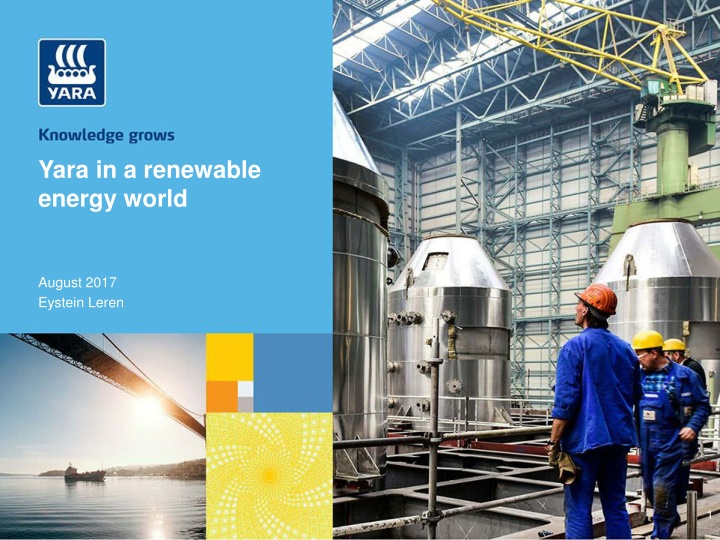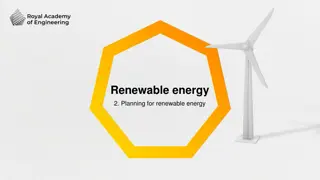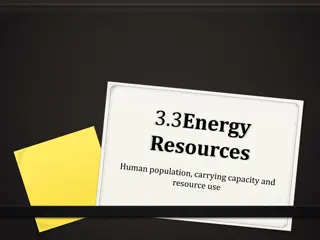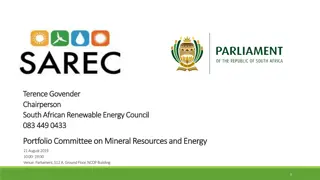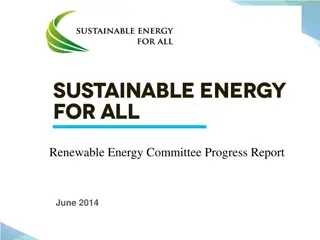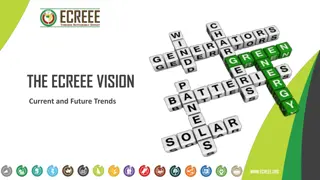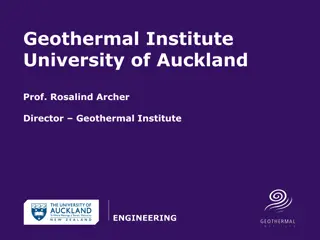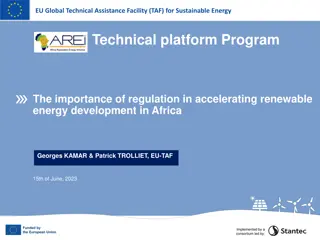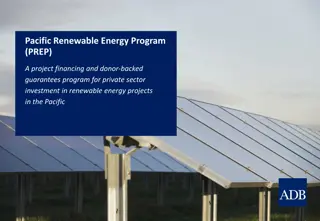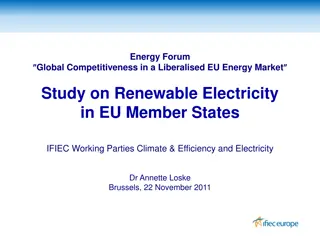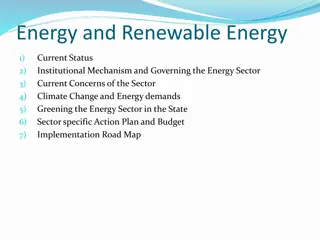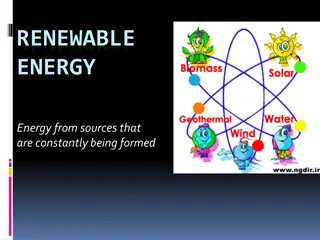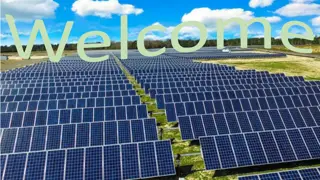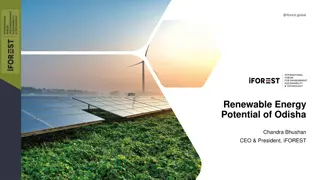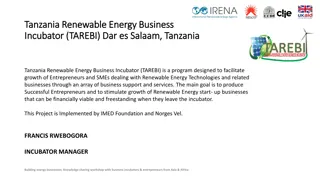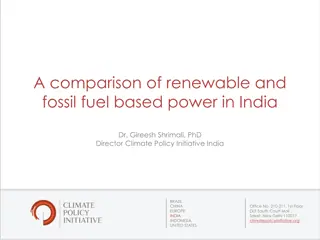Yara's Renewable Energy Transition
Yara, a global agricultural company, is strategically shifting towards renewable energy and sustainable practices to address global challenges. With a focus on reducing GHG emissions, improving resource utilization, and promoting sustainable agriculture, Yara is aiming to play a significant role in feeding the growing world population while safeguarding the environment. By embracing renewable energy sources, a circular economy, and energy efficiency, Yara is committed to driving positive change in the agriculture industry for a more sustainable future.
Download Presentation

Please find below an Image/Link to download the presentation.
The content on the website is provided AS IS for your information and personal use only. It may not be sold, licensed, or shared on other websites without obtaining consent from the author.If you encounter any issues during the download, it is possible that the publisher has removed the file from their server.
You are allowed to download the files provided on this website for personal or commercial use, subject to the condition that they are used lawfully. All files are the property of their respective owners.
The content on the website is provided AS IS for your information and personal use only. It may not be sold, licensed, or shared on other websites without obtaining consent from the author.
E N D
Presentation Transcript
Yara in a renewable energy world August 2017 Eystein Leren 1
Outline 1. Yara at a glance 2. Sustainability ambition 3. Energy consumption/production in Yara 4. How do we believe the energy transition will impact our business 5. We have many questions still.. 2
In numbers Revenue NOK 95.2 Billion (USD 11.4 Billion) Sales to about 160 countries Close to 15,000 employees In 2016 Integrated world scale production, supply chain, distributed production and local blending Crop nutrition products - NPK Fertilizers - Urea - Specialty fertilizer Industrial products - Emission control solutions - Nitrogen chemicals (ammonia, nitric acid) - Nitrate industry applications
We deliver a complete portfolio of offerings What We offer Crop Nutrition solutions Industrial solutions Environmental solutions Basic products Ammonia Urea SSP Nitrates NPK TAN Nitric Acid CN
Responding to global challenges is an integral part of our business model and strategy Future energy systems will affect all parts of our business Resources Resource Efficiency Food Environment Reduced Emissions Sustainable Agriculture Our business is uniquely positioned to provide shared value for shareholders and society
Our ambition is high help feeding a growing world population while protecting our environment GHG emission reduction, and improved resource utilization is driving our transition in energy and raw materials - Renewable energy / electrification - Circular economy / lower material intensity 2020+ Carbon free ammonia and nitrates Low emission application of fertilizer (precision agriculture) Energy efficiency Recovery of materials 2016 Agriculture and climate change are interlinked Increased focus on emission reduction Carbon capture from ammonia feasibility assessment 2000 Yara Technology for nitrous oxide reduction Reduced GHG by 20-25 million tons/yr CO2eq 6
Yara consumes and produces energy Depending on site, Yara consume (and produce) energy in the form of: Natural gas (consumption only) Fuel oil (consumption only) Steam Electricity Production of AMMONIA key contributor to energy consumption and CO2emissions Yara is producing 6 9 million tons of ammonia per year in 11 locations with one or more ammonia plants, 36 mmBTU as natural gas feed and fuel is consumed to produce one metric ton of ammonia Total CO2emissions are about 5 8 million tons/yr (production of merchant liquid carbon dioxide and urea not included) All Yara plants with one exception produce hydrogen by Steam-Methane Reforming (SMR) followed by Haber-Bosch synthesis of ammonia Steam / Electricity Nitric acid by the Ostwald process, is exothermic and generates energy as steam. Yara also operates steam boilers on various sites, and, exceptionally produce electricity where electricity is scarce or not available (isolated systems) SMR Primary reformer (Thyssen-Krupp) 7
Zero emissions Transition to carbon free feed and energy Production of ammonia by water electrolysis and H-B was Hydro default for many years.. Natural gas reforming with CCS might bring CO2emissions down by +90%, but entirely CO2free production is achieved only by changing to carbon-free feed and energy DEMONSTRATED! Hydro Glomfjord full-scale hydrogen by water electrolysis and hydropower (Courtesy of NEL) GHG emission free Post Haber-Bosch technologies are at low TRL, and with varying energy efficiency potential Electrolysis is less energy efficient than SMR, but GHG emission free. The practical application of energy intensive technology as electrolysis relies heavily on the availability of low cost renewable power 8
Potential value chain impact of a transition to variable renewable power Natural gas replacement in hydrogen production Electrification (e.g. electrical steam boilers) GHG free mineral fertilizer to compete with brown products? Urea phase-out? Renewable ammonia as energy carrier (fuel / power-to-power / storage)? Variable renewable energy intermittency effects in production?
The energy transition when, what and how In a world where 50% or more of all energy is renewable, what can we expect? What will the drivers be for the various development trends? A non-exhaustive and partly interlinked list of questions..: Electrification of industry, on what scale and pace? To what extent will electricity replace (hydrocarbon) fuels, and how does that impact the energy market(s)? Intermittent renewable electricity, what will the intermittency effects mean for an industrial consumer? Can we expect the same security of supply as today? Will intermittency compensation measures be on the consumer or supplier side (production/transmission/distribution)? Price development, and price volatility, will average prices go up or down, and what can we expect in terms of volatility and price variations per day/week/month? Electricity production, transmission and storage? What will dominate production? Large and central (e.g. where there is a lot of sun/wind) or decentralized? Can we expect a broad scale development of electricity transmission capacity, e.g. in Europe/large European countries? Any global trends? Where copperplate and where large supply-demand imbalances? To what extent will short and long term storage of energy be required, what will the scale of storage requirements be? What will the market mechanisms be when supply comes from both production and stored energy? 10
